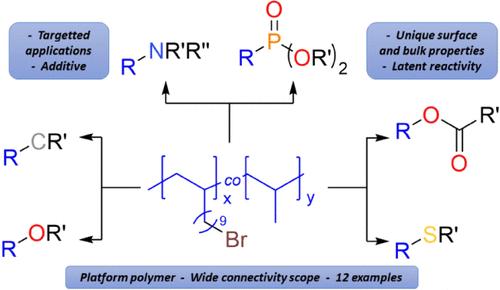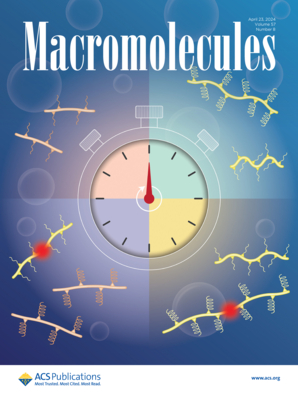功能化聚丙烯:共聚和后改性平台
IF 5.2
1区 化学
Q1 POLYMER SCIENCE
引用次数: 0
摘要
功能性聚丙烯(FPs)被认为是下一代材料的多功能构建模块;然而,由于目前的合成限制,其发展一直受阻。在此,我们报告了通过共聚-后改性两步法制备的多种功能化聚丙烯。使用 C2、C1 和 Cs 不对称催化剂对丙烯和 11-bromo-1-undecene 进行溶液相共聚,可制备出聚(丙烯)-共(11-溴-1-十一烯),共聚单体掺入量可调,最高可达 15.5 mol%,具有一系列触变性(异构、辛二烯和非actic)和较宽的分子量跨度(4-212 kg mol-1)。悬垂溴的潜在亲电反应性被用于三种一般合成路线之一,通过形成一系列共价连接(C-O、C-N、C-S、C-P 和 C-C),从而加入一系列极性取代基。与聚丙烯相比,由此产生的 FP 具有明显改变的体积和表面特性:热稳定性和与金属的粘附性得到改善,润湿性和潜伏反应性得到改变。通过这种策略,可以利用发达的茂金属催化剂和经典的有机取代化学,获得具有高分子量和所选触变性的 FP。本文章由计算机程序翻译,如有差异,请以英文原文为准。

Functionalized Polypropylenes: A Copolymerization and Postmodification Platform
Functional polypropylenes (FPs) are regarded as versatile building blocks for next-generation materials; however, their development has been stymied due to current synthetic limitations. Here, we report a diverse range of functionalized polypropylenes prepared via a two-step copolymerization−postmodification strategy. Solution-phase copolymerization of propylene and 11-bromo-1-undecene using C2, C1, and Cs-symmetric catalysts-afforded poly(propylene)-co-(11-bromo-1-undecene), with tunable comonomer incorporation levels, up to 15.5 mol %, with a range of tacticities (iso-, syndio-, and atactic) and a wide molecular weight span (4−212 kg mol−1). The latent electrophilic reactivity of the pendent bromide has been utilized in one of three general synthetic routes, enabling the incorporation of an array of polar substituents through the formation of a series of covalent connections (C−O, C−N, C−S, C−P, and C−C). The resulting FPs display distinctly altered bulk and surface properties, compared to polypropylene: improved thermal stability and adhesion to metal, altered wettability, and latent reactivity. This strategy allows access to FPs with both high molecular weight and chosen tacticity, taking advantage of well-developed metallocene catalysts and classical organic substitution chemistry.
求助全文
通过发布文献求助,成功后即可免费获取论文全文。
去求助
来源期刊

Macromolecules
工程技术-高分子科学
CiteScore
9.30
自引率
16.40%
发文量
942
审稿时长
2 months
期刊介绍:
Macromolecules publishes original, fundamental, and impactful research on all aspects of polymer science. Topics of interest include synthesis (e.g., controlled polymerizations, polymerization catalysis, post polymerization modification, new monomer structures and polymer architectures, and polymerization mechanisms/kinetics analysis); phase behavior, thermodynamics, dynamic, and ordering/disordering phenomena (e.g., self-assembly, gelation, crystallization, solution/melt/solid-state characteristics); structure and properties (e.g., mechanical and rheological properties, surface/interfacial characteristics, electronic and transport properties); new state of the art characterization (e.g., spectroscopy, scattering, microscopy, rheology), simulation (e.g., Monte Carlo, molecular dynamics, multi-scale/coarse-grained modeling), and theoretical methods. Renewable/sustainable polymers, polymer networks, responsive polymers, electro-, magneto- and opto-active macromolecules, inorganic polymers, charge-transporting polymers (ion-containing, semiconducting, and conducting), nanostructured polymers, and polymer composites are also of interest. Typical papers published in Macromolecules showcase important and innovative concepts, experimental methods/observations, and theoretical/computational approaches that demonstrate a fundamental advance in the understanding of polymers.
 求助内容:
求助内容: 应助结果提醒方式:
应助结果提醒方式:


